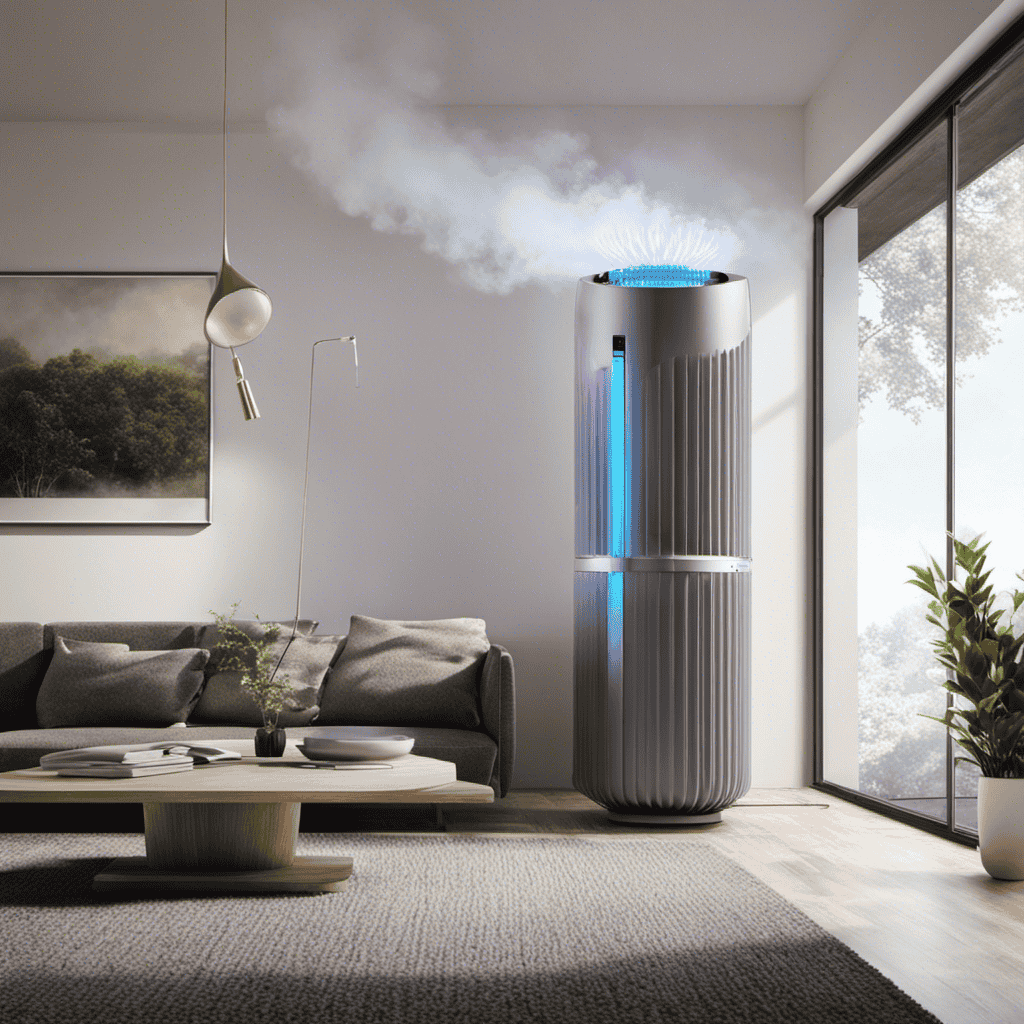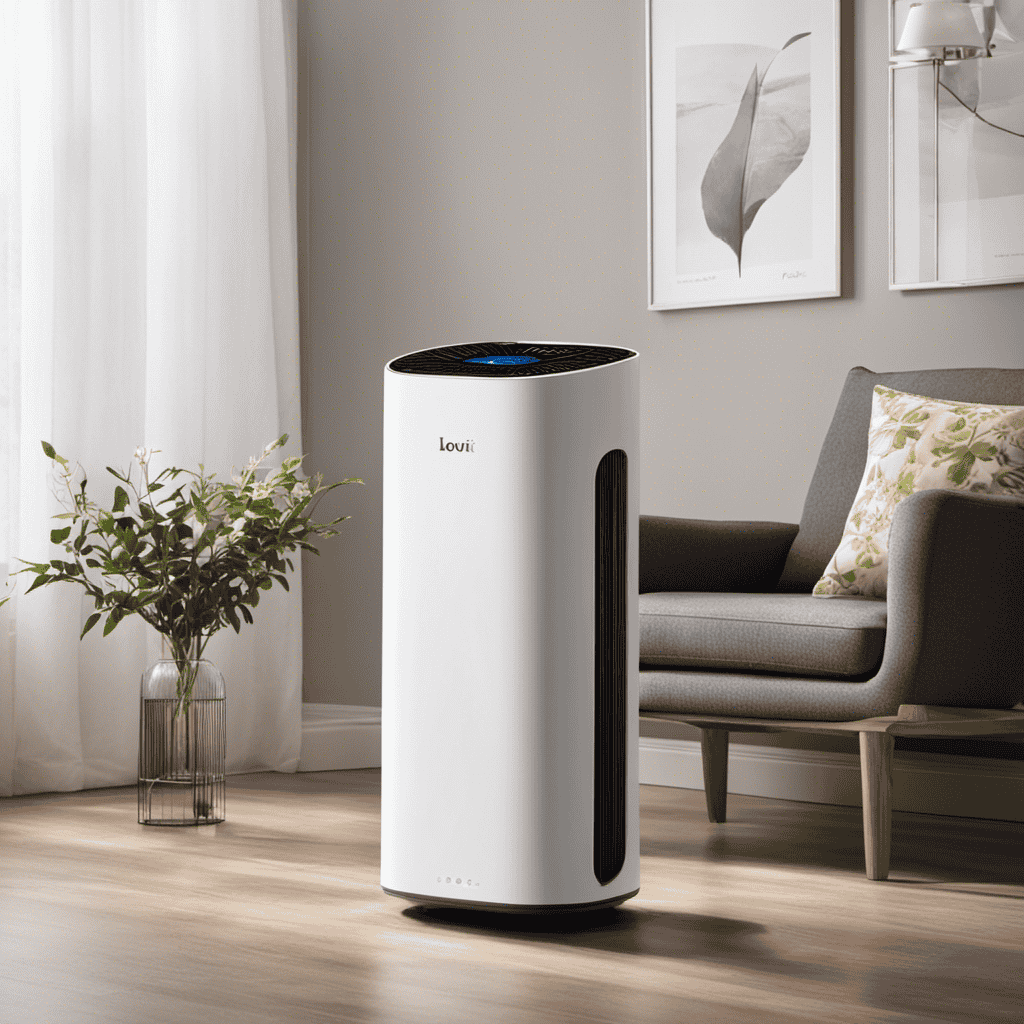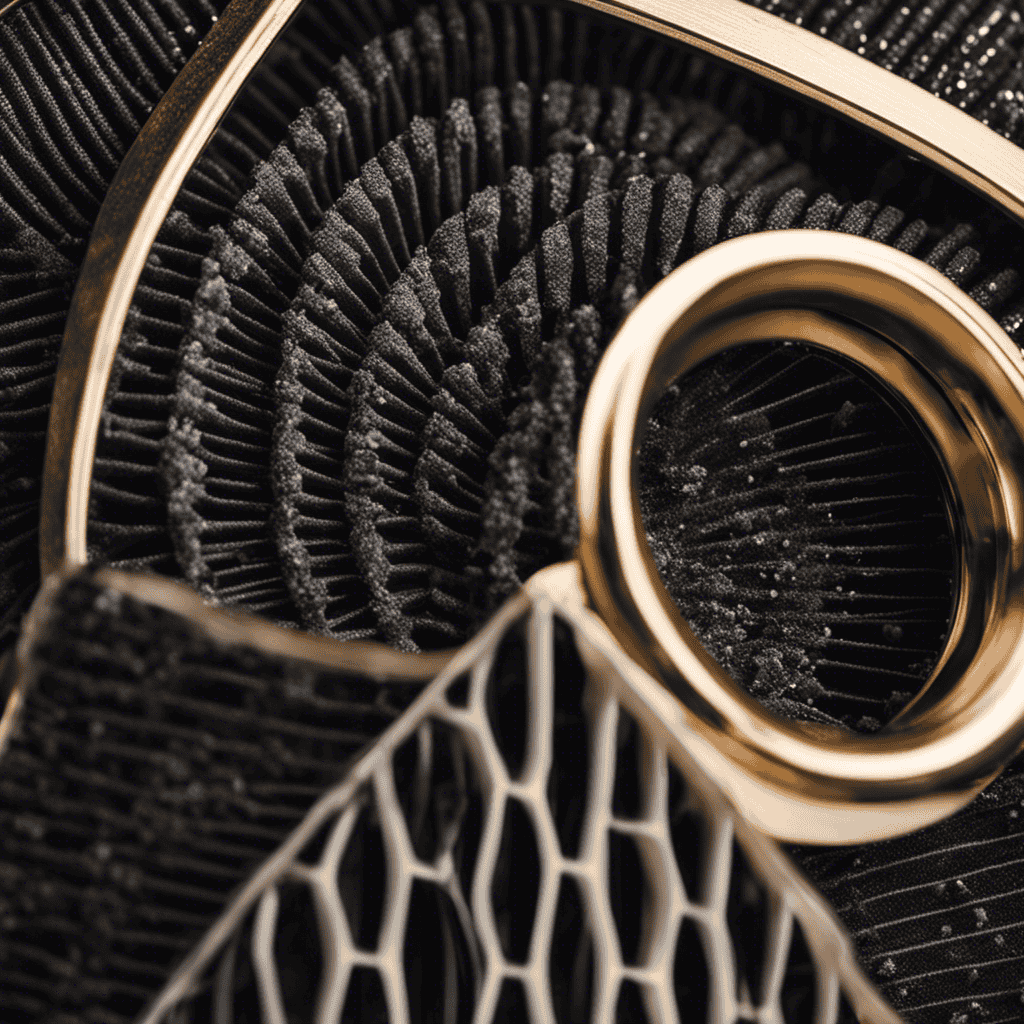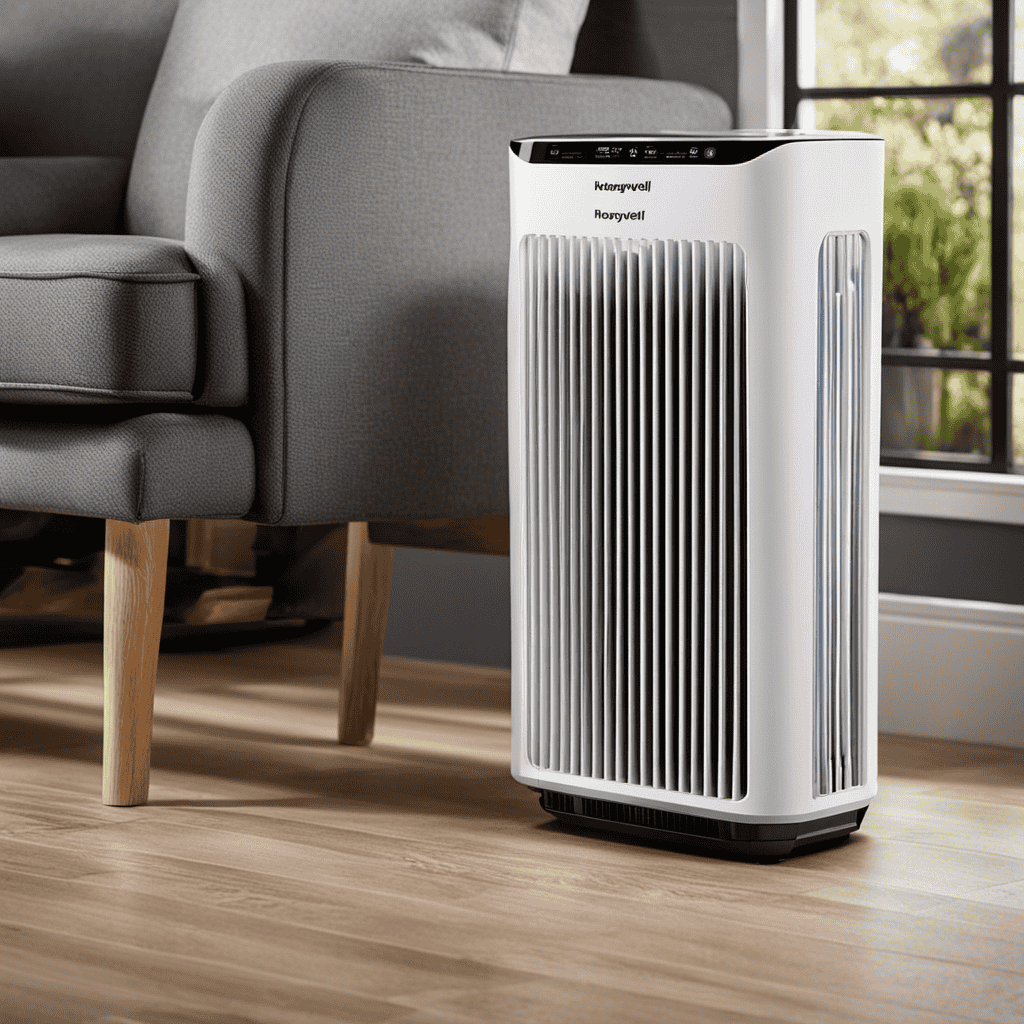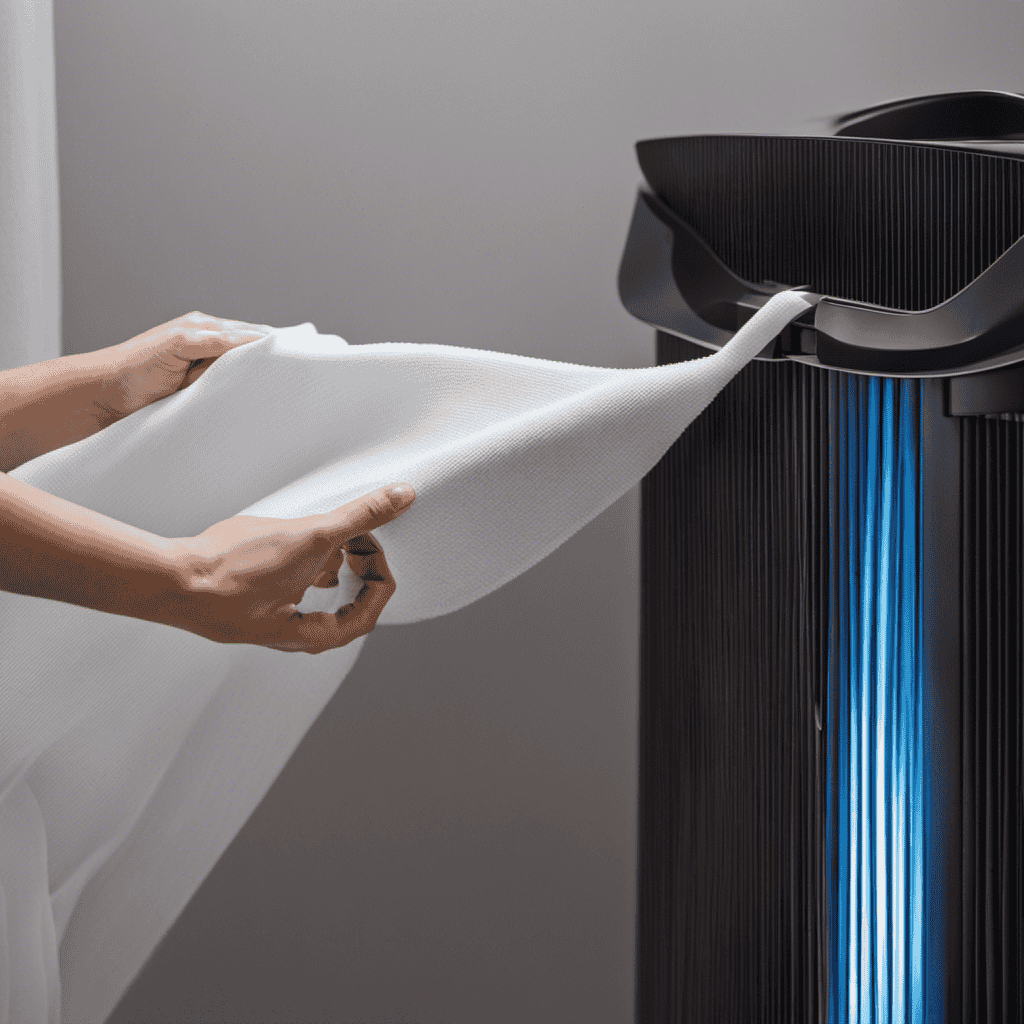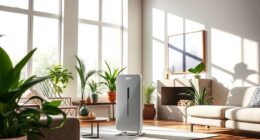As a person who has always been intrigued by how air purifiers work, I am amazed by the effectiveness of ionizers. These compact yet powerful devices can greatly enhance the air quality in your home.
But what exactly does an ionizer do? In this article, we will delve into the science behind ionizers, explore their benefits, and compare them to other air purification technologies.
So, get ready to clear the air and discover the incredible capabilities of ionizers on air purifiers.
Key Takeaways
- Ionizers release negatively charged ions into the air, which attach to airborne particles and remove them from the air.
- Ionizers can help reduce triggers for asthma attacks and improve overall respiratory health.
- They are effective in removing dust, pollen, and mold spores from the air.
- Ionizers on air purifiers can neutralize harmful particles and odors, and enhance overall air quality.
Understanding Ionizers on Air Purifiers
To understand ionizers on air purifiers, it’s important to know that they release negatively charged ions into the air. These ions help remove pollutants by attaching themselves to airborne particles like dust, pollen, and pet dander. Once the particles become charged, they are attracted to surfaces such as walls, floors, or furniture, effectively removing them from the air.
However, it’s worth noting that ionizers can also produce ozone as a byproduct. Ozone is a molecule composed of three oxygen atoms and can be harmful to respiratory health when present in high concentrations. Therefore, when choosing an air purifier with ionizers, it’s crucial to select one that has low ozone production levels. This ensures that the air you breathe remains clean and safe for your respiratory system.
How Ionizers Improve Air Quality
Ionizers can help improve the quality of the air by removing harmful particles. These devices release negative ions into the air, which attach to pollutants such as dust, pollen, and mold spores. The negatively charged particles are then attracted to positively charged surfaces, like walls or furniture, effectively removing them from the air we breathe. This process, known as ionization, can have significant benefits for individuals with asthma or respiratory health issues. By reducing the number of airborne contaminants, ionizers can minimize triggers for asthma attacks and improve overall respiratory health.
| Advantages of Ionizers | Disadvantages of Ionizers |
|---|---|
| Removes harmful particles | Ozone emissions in some models |
| Reduces triggers for asthma attacks | Requires regular maintenance |
| Improves overall respiratory health | May produce minimal amounts of ozone |
Understanding the science behind ionizers can give us further insights into their effectiveness and potential drawbacks.
The Science Behind Ionizers
Understanding the science behind ionizers can give you valuable insights into how they work and their potential impact on air quality.
Ionizers are devices that are designed to improve indoor air quality by removing pollutants from the air. They work by releasing negative ions into the air, which attach themselves to positively charged particles such as dust, allergens, and other indoor pollutants. Once these particles are charged, they become heavier and fall to the ground or are captured by air purifiers.
This process helps to reduce the number of pollutants in the air, which can have a positive effect on respiratory health. By removing these pollutants, ionizers can help to alleviate symptoms of respiratory conditions such as asthma and allergies.
Transitioning into the subsequent section discussing the benefits of using an ionizer on an air purifier, let’s explore how this combination can further enhance air quality.
Benefits of Using an Ionizer on an Air Purifier
In this discussion, I will explore the benefits of using an ionizer on an air purifier in relation to air quality enhancement, as well as allergen and pollutant removal.
By utilizing ionization technology, an air purifier with an ionizer can effectively improve the overall air quality by neutralizing harmful particles and odors.
Additionally, the ionizer attracts and traps allergens and pollutants, such as dust, pollen, and pet dander, making it an excellent choice for those with respiratory sensitivities or allergies.
Air Quality Enhancement
To improve the air quality in your home, you can rely on the ionizer feature of an air purifier. Air ionizers work by emitting negative ions into the air, which attach themselves to positively charged particles such as dust, pollen, and other allergens. These ions cause the particles to become heavy and eventually fall to the ground, effectively removing them from the air you breathe.
The use of air ionizers has been linked to improved respiratory health, as they can help reduce the presence of irritants that can trigger allergies or worsen respiratory conditions. Indoor air pollution, which can be caused by various sources such as cooking, cleaning chemicals, and pet dander, can be effectively mitigated by the ionizer feature of an air purifier.
With the air ionizer feature, the air purifier becomes a powerful tool in enhancing the overall air quality in your home. However, it is important to note that air ionizers alone may not be sufficient in completely eliminating all allergens and pollutants.
In the next section, we will explore how air purifiers go beyond ionization to provide comprehensive allergen and pollutant removal, ensuring a cleaner and healthier indoor environment.
Allergen and Pollutant Removal
If you want to ensure a cleaner and healthier indoor environment, you should consider the comprehensive allergen and pollutant removal capabilities of an air purifier. These devices are designed to capture and eliminate airborne particles such as dust, pollen, pet dander, mold spores, and even volatile organic compounds (VOCs) that can be harmful to your respiratory system. One of the key technologies used in air purifiers is ionizer technology, which helps to further enhance their effectiveness. Ionizers release negatively charged ions into the air, which attach to positively charged particles like dust and allergens, causing them to become heavy and fall to the ground or stick to surfaces. This helps to reduce the number of airborne pollutants in your indoor environment, providing you with cleaner and fresher air to breathe.
| Benefits of Air Purifiers |
|---|
| Removes allergens |
| Eliminates pollutants |
| Reduces respiratory issues |
Incorporating ionizer technology into air purifiers enhances their ability to capture and remove these particles, making them a valuable tool in improving indoor air quality.
Ionizers Vs. Other Air Purification Technologies
When it comes to air purifiers, ionizers offer a different approach to cleaning the air compared to other technologies. Ionizers work by emitting negatively charged ions into the air, which attach to positively charged particles such as dust, pollen, and pet dander. This causes the particles to become heavy and fall to the ground or adhere to nearby surfaces, effectively removing them from the air.
In contrast, HEPA filters physically trap particles as air passes through them. One advantage of ionizers is their ability to remove particles smaller than what a HEPA filter can capture. However, it is important to note that ionizers can also produce small amounts of ozone as a byproduct, which can be harmful to human health if present in high concentrations.
Understanding these differences is crucial in selecting the right air purifier for your needs. Now, let’s explore how ionizers remove particulate matter.
How Ionizers Remove Particulate Matter
When it comes to understanding the ionization process, it is essential to consider the fundamental principles behind it.
Ionizers work by emitting negatively charged ions into the air, which then attach to positively charged particles like dust, pollen, and other pollutants.
This process causes the particles to become too heavy to remain airborne, effectively removing them from the air we breathe.
The benefits of ionizers are vast, ranging from improved air quality to reduced allergies and respiratory issues.
Ionization Process Explained
To understand how an ionizer works on your air purifier, let’s break down the ionization process.
- Ionization benefits:
- Removes harmful pollutants from the air
- Reduces allergens and irritants
- Helps neutralize odors
- Improves overall air quality
The ionizer mechanism in an air purifier works by releasing negatively charged ions into the air. These ions attach themselves to airborne particles such as dust, pollen, and pet dander. Once the particles become negatively charged, they are attracted to positively charged plates or surfaces within the air purifier. This process is known as electrostatic attraction.
Once the particles are trapped on the plates or surfaces, they are effectively removed from the air, significantly reducing their presence and improving air quality. It’s important to note that ionizers do not actually filter the air like traditional filters. Instead, they use ionization technology to neutralize and remove particulate matter.
Benefits of Ionizers
You can enjoy the benefits of ionizers, such as removing harmful pollutants, reducing allergens and irritants, neutralizing odors, and improving overall air quality.
When it comes to respiratory health, ionizers play a crucial role. These devices work by releasing negatively charged ions into the air. These ions attach themselves to airborne particles like dust, pollen, and pet dander, making them heavier and causing them to fall to the ground or stick to surfaces. This process effectively reduces the number of allergens and irritants in the air, which can be especially beneficial for individuals with respiratory conditions such as asthma or allergies.
Additionally, ionizers can also neutralize odors by breaking down the molecules responsible for unpleasant smells.
Furthermore, ionizers are known for their energy efficiency, often consuming less power compared to other air purification technologies, making them an economical choice for improved indoor air quality.
Effectiveness Against Pollutants
Ionizers are highly effective at reducing the presence of pollutants in the air. As a scientist studying air purification techniques, I have found that ionizers play a crucial role in improving indoor air quality. Here are some key reasons why ionizers are so effective:
-
Ionizers release negative ions into the air, which attach to airborne particles and cause them to become heavy, eventually falling to the ground.
-
These devices help remove various pollutants, including dust, pollen, pet dander, and mold spores.
-
Ionizers can also neutralize harmful gases and odors by converting them into less harmful substances.
-
Unlike filters, which need regular replacement, ionizers require minimal maintenance and are cost-effective in the long run.
Ionizers and Allergens: What You Need to Know
When it comes to ionizers and allergens, it’s important to understand their relationship and how they can affect your air quality. Ionizers are devices commonly found in air purifiers that use negative ions to attract and neutralize airborne particles. These particles can include allergens such as pet dander, dust mites, and pollen. By emitting negative ions, ionizers cause these particles to become positively charged, making them heavier and causing them to fall out of the air onto surfaces. This can be beneficial for individuals with asthma, as it reduces the presence of allergens that can trigger their symptoms. In the case of pet dander, ionizers can help remove these particles from the air, providing relief for those with pet allergies.
| Allergen | Ionizer Effect |
|---|---|
| Pet Dander | Reduces |
| Dust Mites | Reduces |
| Pollen | Reduces |
The Role of Ionizers in Eliminating Odors
When it comes to eliminating odors, there are various techniques that can be employed.
One such technique is the use of ionizers, which are designed to release negative ions into the air to neutralize and eliminate odors.
These ions attach themselves to airborne odor particles, causing them to become heavier and fall to the ground, effectively removing them from the air.
However, it is important to note that ionizers are not the only option available, as traditional filters can also play a role in odor elimination by capturing and trapping odor-causing particles.
Odor Elimination Techniques
To get rid of unpleasant smells, you can use an ionizer on your air purifier. An ionizer is a device that releases negatively charged ions into the air. These ions attach themselves to airborne particles, such as pet dander and odors, causing them to become heavy and fall to the ground.
Here are four effective odor elimination techniques using ionizers:
-
Ionization: The ionizer releases ions that bind to odor molecules, neutralizing them and reducing their presence in the air.
-
Air circulation: Proper airflow helps distribute the ions throughout the room, ensuring maximum odor elimination.
-
Activated carbon filter: Combined with the ionizer, this filter traps and absorbs odor-causing molecules.
-
Regular maintenance: Cleaning and replacing the ionizer and filters regularly ensures optimal performance and odor control.
Ionizers and Fresh Air
Incorporating an ionizer into your air purifier helps freshen the air in your home by releasing negative ions into the air. These ions attach themselves to airborne particles, such as dust, pollen, and pet dander, causing them to become heavy and fall to the ground. This process, known as ionization, reduces the number of allergens and irritants in the air, improving respiratory health.
For asthma sufferers, the benefits of air ionizers are particularly significant. Asthma is a chronic respiratory condition characterized by inflammation and narrowing of the airways. By removing allergens and irritants from the air, ionizers can help reduce asthma triggers and alleviate symptoms. Additionally, the negative ions released by ionizers have been shown to have a calming effect on the respiratory system, reducing stress and promoting relaxation.
Overall, incorporating an ionizer into your air purifier can have a positive impact on respiratory health, especially for individuals with asthma.
Ionizers Versus Traditional Filters
If you want to compare ionizers and traditional filters, you’ll find that both have their pros and cons.
When it comes to energy consumption, ionizers have an advantage over traditional filters. They require less energy to operate, making them more energy-efficient.
On the other hand, traditional filters may be more effective in capturing larger particles like dust and pollen.
In terms of indoor air pollution, ionizers can help to reduce the presence of certain pollutants by releasing negative ions that attach to them and make them heavier, causing them to fall to the ground.
However, ionizers may not be as effective in removing smaller particles or volatile organic compounds (VOCs).
It’s important to consider these factors when deciding between an ionizer and a traditional filter for your air purifier.
Ionizers and Bacteria: How They Work Together
Ionizers and bacteria work together to eliminate harmful particles from the air. Ionizers are devices that release negatively charged ions into the air. These ions attach themselves to airborne particles, such as dust, pollen, and bacteria, causing them to become negatively charged. Once negatively charged, these particles are attracted to positively charged surfaces, such as walls or furniture, and are effectively removed from the air.
When it comes to bacteria, ionizers play a crucial role in improving respiratory health. Bacteria can cause various respiratory infections and illnesses, including common colds, flu, and pneumonia. Ionizers have been shown to effectively reduce the presence of bacteria in the air, thus minimizing the risk of respiratory infections. By eliminating bacteria from the air, ionizers create a healthier environment, particularly for individuals with compromised immune systems or respiratory conditions.
| Pros | Cons |
|---|---|
| Effectively removes bacteria from the air | Can produce ozone, which can be harmful |
| Improves respiratory health | May not effectively remove all types of bacteria |
| Creates a healthier environment | Can have limited effectiveness in large spaces |
| Reduces the risk of respiratory infections | Requires regular maintenance and cleaning |
Common Misconceptions About Ionizers
When considering the use of ionizers, it’s important to address the potential health risks associated with these devices.
Some studies have suggested that ionizers may produce harmful byproducts such as ozone, which can have adverse effects on respiratory health.
Additionally, the effectiveness of ionizers in improving air quality has been questioned. Some research indicates that their impact on reducing pollutants may be limited.
Ionizer Health Risks
There’s no denying that ionizers have been linked to potential health risks. However, it’s important to understand that the benefits of ionizers cannot be overlooked. Ionizer technology has revolutionized the air purifier industry, providing cleaner and fresher air for us to breathe.
Here are some key benefits and facts about ionizers:
- Ionizers help remove airborne particles such as dust, pollen, and pet dander, improving indoor air quality.
- They are effective in reducing odors and neutralizing harmful gases, creating a more pleasant living environment.
- Ionizers can help alleviate symptoms of allergies and asthma by reducing the presence of airborne allergens.
- They work by emitting negative ions that attach themselves to positively charged particles, causing them to fall out of the air and onto surfaces.
While it is crucial to consider the potential health risks associated with ionizers, it’s equally important to acknowledge the numerous benefits they offer in creating a healthier and cleaner indoor environment.
Ionizer Effectiveness Questioned?
Despite the controversy surrounding their effectiveness, it’s worth noting that many people have reported positive results when using ionizers.
However, it is crucial to address the ionizer safety concerns and ensure proper maintenance for optimal performance.
Ionizers work by releasing negatively charged ions into the air, which attach to positively charged particles like dust, allergens, and pollutants. These particles then become too heavy to remain airborne and settle on surfaces, reducing their presence in the air.
However, some studies suggest that ionizers can generate ozone, a harmful gas that can worsen respiratory conditions. To mitigate this risk, it is essential to choose an ionizer with low ozone emissions and follow manufacturer instructions for safe usage.
Regular cleaning of the ionizer plates and filters is also crucial for maintaining its effectiveness.
Safety Considerations When Using an Ionizer
Using an ionizer on an air purifier comes with safety considerations. It is important to understand and follow proper maintenance procedures to ensure the safe and effective operation of the ionizer. Here are some key points to keep in mind:
-
Regular air purifier maintenance: Make sure to clean or replace the filters as recommended by the manufacturer. This helps maintain optimal airflow and prevents the accumulation of dust and debris in the ionizer.
-
Ionizer cleaning: Periodically clean the ionizer plates or needles to remove any buildup of particles. Follow the manufacturer’s instructions for cleaning and be cautious when handling the ionizer components.
-
Safety precautions: Always unplug the air purifier before performing any maintenance or cleaning tasks. This prevents the risk of electric shock. Additionally, wear gloves or use tools to avoid direct contact with the ionizer plates or needles.
Ionizers and Mold: A Powerful Combination
In the previous section, I discussed the importance of safety when using an ionizer on an air purifier. Now, let’s dive into another aspect of ionizers: their effectiveness in reducing asthma triggers and pet dander.
Asthma is a respiratory condition that can be worsened by airborne pollutants, such as dust mites, pollen, and pet dander. Ionizers work by emitting negatively charged ions into the air, which attach to positively charged particles like these allergens. This causes them to become heavier and fall to the ground, reducing their presence in the air we breathe.
When it comes to pet dander, ionizers can play a crucial role in removing these allergens from the air. By neutralizing the positive charge on pet dander particles, ionizers make them less likely to become airborne and easier to capture in the air purifier’s filters.
With their ability to reduce asthma triggers and pet dander, ionizers prove to be a valuable tool for those suffering from allergies or asthma.
Now, let’s explore another important aspect of ionizers: their effectiveness in clearing the air of volatile organic compounds (VOCs).
Ionizers and VOCs: Clearing the Air
Ionizers are effective at reducing the presence of volatile organic compounds (VOCs) in the air we breathe. These compounds can be harmful to our health, especially for individuals with asthma. Here’s how ionizers help manage asthma and indoor air pollution:
-
Ionizers release negatively charged ions into the air, which attach to positively charged VOC particles, causing them to become heavier and fall to the ground.
-
By reducing the levels of VOCs in the air, ionizers help prevent asthma attacks triggered by these compounds.
-
Ionizers also neutralize airborne allergens, such as pollen and pet dander, further improving indoor air quality for asthma sufferers.
-
Additionally, ionizers can eliminate odors caused by VOCs, making the indoor environment more pleasant and comfortable.
With their ability to reduce VOCs and improve air quality, ionizers play a crucial role in managing asthma and reducing indoor air pollution.
The Effectiveness of Ionizers in Removing Smoke
In our previous discussion, we explored how ionizers can effectively remove volatile organic compounds (VOCs) from the air. Now, let’s delve into another crucial aspect of ionizers: their effectiveness in reducing allergies and their impact on respiratory health.
Allergies, such as hay fever and asthma, can be triggered by airborne allergens like pollen, dust mites, and pet dander. Ionizers can play a significant role in alleviating these allergies by attracting and trapping these allergens. As the ionizer emits negatively charged ions, they attach to the airborne allergens and make them heavy, causing them to fall to the ground or get trapped in the air purifier’s filters.
By reducing the presence of allergens in the air, ionizers can help individuals breathe cleaner and healthier air, ultimately improving their respiratory health. However, it is essential to note that ionizers should be used in conjunction with other air purification methods, such as HEPA filters, for optimal results.
Tips for Choosing an Air Purifier With an Ionizer
When choosing an air purifier with an ionizer, there are a few important factors to consider. First, you should think about the size of the room and the CADR rating to ensure that the purifier effectively cleans the air. Ionizers are a valuable feature because they help eliminate airborne particles by releasing negatively charged ions. However, it’s important to note that air purifiers with ionizers have specific maintenance requirements and energy consumption considerations.
One important factor to consider is regular cleaning. Air purifiers with ionizers need to be cleaned regularly to ensure optimal performance. This includes cleaning the ionizing wires or plates to remove any buildup of particles or dust.
Another factor to consider is filter replacement. While the ionizer helps remove particles, it’s still important to replace the filters regularly to maintain clean and healthy air. Check the manufacturer’s recommendations for filter replacement intervals.
Energy consumption is also something to think about. Air purifiers with ionizers may consume more energy compared to models without this feature. Consider the energy efficiency rating of the purifier to make an informed decision.
Noise level is another consideration. Some air purifiers with ionizers can produce a faint buzzing sound. If noise is a concern for you, look for models with low noise levels.
Is There a Difference in Ionizer Functionality Between Air Purifiers?
Yes, there is a difference in ionizer function in air purifiers. Some air purifiers use ionizers to remove impurities from the air, while others do not. Those with ionizers release negatively charged ions that attach to positively charged particles, making them too heavy to stay airborne, thus improving air quality.
Frequently Asked Questions
How Much Energy Does an Ionizer Consume?
An ionizer on an air purifier consumes a small amount of energy. However, its effectiveness in removing pollutants from the air is significant. It releases negative ions that attach to airborne particles, making them too heavy to float and easier to filter out.
Can an Ionizer Be Used in a Small Room?
In a small room, an ionizer can provide benefits by removing pollutants from the air. However, it has limitations as it may produce ozone and may not be as effective in larger spaces.
Are Ionizers Safe for Pets?
Ionizers may seem harmless, but they pose potential risks to pets’ health. They release charged particles that can irritate their respiratory systems and worsen allergies. Caution should be exercised when using ionizers around our furry friends.
How Often Should the Ionizer Plates Be Cleaned?
I clean the ionizer plates of my air purifier regularly to ensure optimal performance. The frequency of cleaning depends on the level of pollutants in the air, but I generally do it every few weeks.
Can Ionizers Be Used in Conjunction With Other Air Purifying Technologies?
Combining ionizers with other air purifying technologies can enhance overall effectiveness. However, it’s important to consider ozone production. Ionizers can produce ozone, which may be harmful in high concentrations. HEPA filters are more effective at removing particles.
Conclusion
In conclusion, the use of ionizers on air purifiers can greatly enhance the quality of indoor air. With their ability to generate negative ions, ionizers can effectively neutralize harmful pollutants and allergens, providing a healthier environment for individuals.
One interesting statistic to note is that ionizers have been found to significantly reduce airborne mold spores by up to 95%. This highlights the powerful combination of ionizers and their effectiveness in improving air quality by tackling specific contaminants.
When considering an air purifier, choosing one with an ionizer can be a wise choice for optimal purification.
